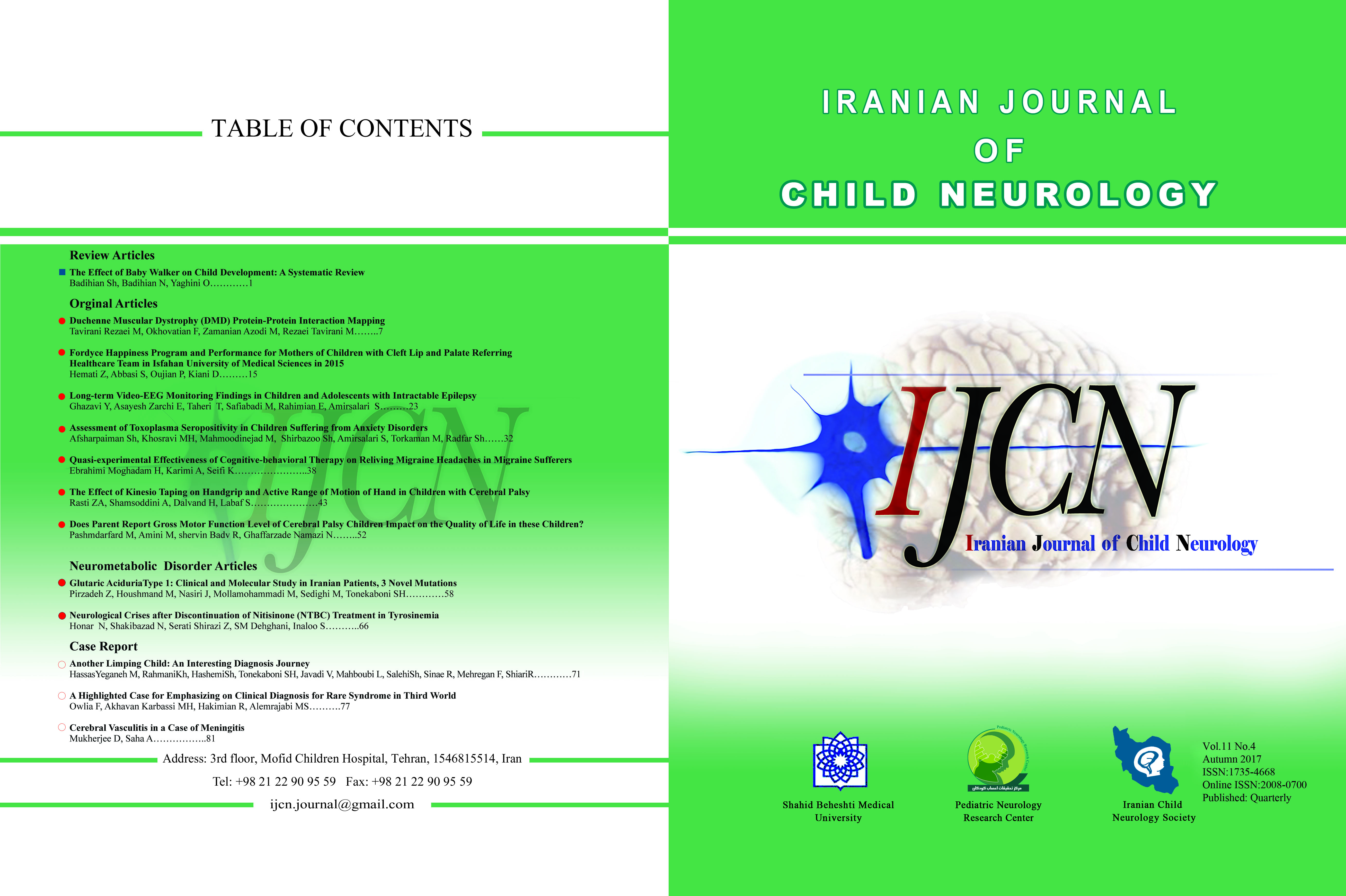Glutaric aciduria type 1: clinical, biochemical, neuroimaging and molecular findings in Iranian patients
Iranian Journal of Child Neurology,
Vol. 11 No. 4 (2017),
13 September 2017
,
Page 58-65
https://doi.org/10.22037/ijcn.v11i4.10389
Abstract
Objective: Glutaric aciduria type 1 (GA1), is a rare, treatable neuro- metabolic disease, due to Glutaryl - CoA dehydrogenase (GCDH) gene mutation. More than 200 mutations in GCDH are reported. In regions without Neonatal blood screening (NBS), patients are diagnosed in symptomatic period. This study was the first report of clinical manifestation, neuroimaging and laboratory data including GCDH gene mutation in Iranian GA1 patients.
Materials and Methods: In this cross-sectional, descriptive study, clinical manifestation, neuroimaging and metabolic finding of eleven Iranian GA1 patients were evaluated. GCDH mutations of patients were studied, too.
Results: All of patients were diagnosed before 32 months old. Clinical presentation of GA1 includes acute encephalopathic crisis and / or developmental delay. Neuroimaging of patients were typical .We found three novel mutations in GCDH gene in Iranian GA1 patients. Two new mutations patients were low excretors of glutaric acid. There is no correlation of genotype and phenotype in our patients.
Conclusion: Physician must remember GA1 in differential diagnosis of macrocephaly, developmental delay, acute encephalopathy, dystonia and dyskinesia. Early detection, proper treatment and selective screening of patients’ siblings can prevent neurologic disabilities.- Neuroimaging
- Glutaric aciduria
- Mutation
How to Cite
References
Tortorelli S, Hahn SH, Cowan TM, Brewster TG, Rinaldo P, Matern D. The urinary excretion of glutarylcarnitine is an informative tool in the biochemical diagnosis of glutaric acidemia type I. Mol Genet Metab 2005; 84: 137-43.
Kölker S, Burgard P, Okun JG, Schulze-Bergkamen A, Assmann B, Greenberg CR, et al. Looking forward--an evidence-based approach to glutaryl-CoA dehydrogenase deficiency. J Inherit Metab Dis 2004; 27: 921-6.
Monavari AA, Naughten ER. Prevention of cerebral palsy in glutaric aciduria type 1 by dietary management. Arch Dis Child 2000; 82: 67-70. doi: 10.1136/adc.82.1.67.
Keyser B, Mühlhausen C, Dickmanns A, Christensen E, Muschol N, Ullrich K, et al. Disease-causing missense mutations affect enzymatic activity, stability and oligomerization of glutaryl-CoA dehydrogenase (GCDH). Hum Mol Genet 2008; 17: 3854-63. doi: 10.1093/hmg/ddn284.
Zschocke J, Quak E, Guldberg P, Hoffmann GF. Mutation analysis in glutaric aciduria type I. J Med Genet 2000; 37: 177-81. doi: 10.1136/jmg.37.3.177.
Mushimoto Y, Fukuda S, Hasegawa Y, Kobayashi H, Purevsuren J, Li H, et al. Clinical and molecular investigation of 19 Japanese cases of glutaric acidemia type 1. Mol Genet Metab 2011; 102: 343-8. doi: 10.1016/j.ymgme.2010.11.159.
Basinger AA, Booker JK, Frazier DM, Koeberl DD, Sullivan JA, Muenzer J. Glutaric acidemia type 1 in patients of Lumbee heritage from North Carolina. Mol Genet Metab 2006; 88: 90-92.
Boneh A, Beauchamp M, Watkins J, Peters H, Yaplito_ Lee J. Newborn screening for glutaric aciduria type 1 in victoria : Treatment and outcome . Mol Genet Metab 2008; 94: 287–291. doi: 10.1016/j.ymgme.2008.03.005.
Kyllerman M, Skjeldal O, Christensen E, Hagberg G, Holme E, Lönnquist T, et al. Long-term follow – up, neurological outcome and survival rate in 28 Nordic patients with glutaric aciduria type 1. Eur J Paediatr Neurol 2004; 8: 121-129.
Heringer J, Boy SP, Ensenauer R, Assmann B, Zschocke J, Harting I, et al. Use of guidelines improves the neurological outcome in glutaric aciduria type I. Ann Neurol 2010; 68: 743-52. doi: 10.1002/ana.22095.
Neumaier-Probst E, Harting I, Seitz A, Ding C, Kolker S. Neuroradiological findings in glutaric aciduria type I (glutaryl-CoA dehydrogenase deficiency). J Inherit Metab Dis 2004; 27: 869-76.
Twomey EL, Naughten ER, Donoghue VB, Ryan S. Neuroimaging finding in glutaric aciduria type1. Ped Radio 2003; 33: 823-830.
Hsieh CT, Hwu WL, Huang YT, Huang AC, Wang SF, Hu MH, et al. Early detection of glutaric aciduria type 1 by newborn screening in Taiwan. J Formos Med Assoc 2008; 107: 139–144. doi: 10.1016/S0929-6646(08)60127-8.
van der Watt G, Owen EP, Berman P, Meldau S, Watermeyer N, Olpin SE, et al. Glutaric aciduria type 1 in South Africa-high incidence of glutaryl-CoA dehydrogenase deficiency in black South Africans. Mol Genet Metab 2010; 101: 178-82. doi: 10.1016/j.ymgme.2010.07.018.
Kölker S, Christensen E, Leonard JV, Greenberg CR, Boneh A, Burlina AB, et al. Diagnosis and management of glutaric aciduria type I--revised recommendations. J Inherit Metab Dis 2011; 34: 677-94. doi: 10.1007/s10545-011-9289-5.
Greenberg CR, Prasad AN, Dilling LA, Thompson JR, Haworth JC, Martin B, et al. Outcome of the first 3-years of a DNA-based neonatal screening program for glutaric acidemia type 1 in Manitoba and northwestern Ontario, Canada. Mol Genet Metab 2002; 75: 70-8.
Kölker S, Garbade SF, Boy N, Maier EM, Meissner T, Mühlhausen C, et al. Declin of acute encephalopathic crises in children with glutaryl – co A dehydrogenase deficiency identified by newborn screening in Germany. Pediatr Res 2007; 62: 357-363.
- Abstract Viewed: 710 times
